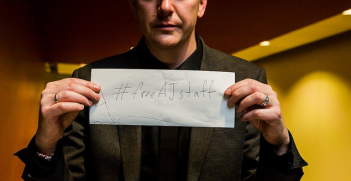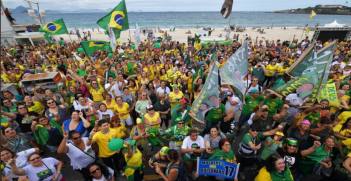When Turnbull Met Trump: The Allure of Orthodoxy and the Peril of Sentimentality

This week’s meeting between US President Donald Trump and Australian Prime Minister Malcolm Turnbull has provided a much-needed opportunity to re-emphasise the importance of the alliance for both countries. The risk is that the Intrepid rendezvous makes the relationship look more like a museum piece.
In one respect, the symbolism of US President Donald Trump and Australian Prime Minister Malcolm Turnbull meeting aboard the USS Intrepid in New York on Thursday could not be more ideal.
After all, the moment will surely provide the perfect opportunity to showcase an alliance which has always—and rightly—cherished its past. That it coincides with the 75th anniversary of the Battle of the Coral Sea, in which these two allies combined to turn back the tide of Japanese imperialism in the Second World War, will only add to the poignancy of the occasion. It is ‘altogether fitting and proper’, no less, that Australia and the United States commemorate the sacrifice and the struggles of yore.
The rhetoric of brothers in arms will no doubt flow. So will the recitals about current defence cooperation in the Middle East, the rotation of US marines through Darwin and the common cause in meeting the threat of North Korean belligerence.
Trump came to office as a strong critic of the US alliance system. He was not a believer. Throughout his campaign, he was unequivocal in asking allies to do more. He dismissed NATO as obsolete and threatened to apply the fiscal blowtorch to bellies in Seoul and Tokyo, wanting them to pay more for the cost of stationing US troops there. Seemingly, he wanted to turn history’s page; it was now up to allies to do more for America, not the other way around.
Some of Trump’s more lurid prescriptions have been modified as the reality of governing and the complexity of the global strategic terrain have combined to mug the president. And an hour or so striding the decks of the Intrepid, therefore, might very well continue his education by showing what America can do with its allies when a formidable enemy threatens the global order.
It will, of course, also present the two leaders with a chance to reconcile after their turbulent conversation in late January. Just imagine: all those photos of a raging Trump, America’s very own Tiberius on the telephone, will be replaced by the two leaders fore and aft the USS Intrepid, no doubt strategically positioned beneath its now silent guns.
But the optics of this visit are also risky. Trump may very well take away from his time on deck a renewed appreciation of what America has done for its friends in the past. It might only strengthen his transactional view of alliances. He may only become more adamant that history proves him right.
Ever since that now infamous phone call and its aftermath, when Trump said he would honour the refugee resettlement deal bequeathed to him by his predecessor, speculation has been rife as to what the prime minister might have offered Trump in return. A transactional president, some (including this writer) suggested, would want a quid pro quo. The government and its supporters have always attempted to quash that kind of speculation. But the prime minister himself seemed to lay the groundwork for some kind of offering when at a doorstop interview in the Middle East on Anzac Day he suggested that Australia would consider any requests for an increased military commitment there.
It would be difficult to imagine Turnbull arriving in New York with nothing to offer Trump. Time will tell.
Make no mistake: Malcolm Turnbull needed this meeting. He needed to be able to show that the relationship with America still guarantees access at the highest level. He did not want to have to do a Whitlam and send an envoy to Washington and practically beg for an audience with the president.
But the two leaders are not meeting in the Oval Office, or at Mar-a-Lago. So it’s most certainly a step down in protocol terms. Clearly, the prime minister’s office would have preferred a White House meeting, even if that didn’t come with the formal welcome on the South Lawn, the overnight stay at Blair House and the mellifluous toasts at a state dinner. The last prime minister to be feted aboard a floating vessel in the US was John Gorton when he hopped aboard the presidential yacht Sequoia in early 1968 to conduct his first meeting with Lyndon Johnson. It didn’t go well. They couldn’t hear each other above the noise of the engine as it chugged up the Potomac towards George Washington’s Mount Vernon.
Lest it not be forgotten: Turnbull and Trump, after all, are meeting aboard a floating museum. In The Interpreter recently, I offered a gentle critique of Australian Ambassador Joe Hockey’s remarkable attempts to remind the Trump administration of this joint wartime past via the coming production of a television documentary, no less, recounting the history of the battles that the US and Australia have fought together since Le Hamel on the Western front in 1918. Turnbull has made this language his own, telling the vice president in Sydney recently that they were in fact celebrating “100 years of mateship”. The fusion of Anzac and the alliance continues.
Long lost, it seems is the Turnbull who had a healthy scepticism about the relationship with Washington. “Extravagant professions of loyalty and devotion to the United States”, he once quipped before becoming prime minister, were simply unnecessary, and he made the case that Australia’s job was to prevent US-China competition from spiralling out of control and towards military conflict.
This visit, which alliance sentimentalists will welcome as a reaffirmation of all that the alliance has stood for in the past, does carry risks. It may project a view of the relationship that is literally moored to memory, failing to engage in the more difficult conversations about what the American posture in Asia will look like in the years ahead, and what that means for Australia.
The very real danger is that it will be literally awash with cosy sentimentality, putting on display an alliance that appears to be cruising in its own sea of complacency and nostalgia.
James Curran is professor of history at the University of Sydney and a nonresident fellow at the Lowy Institute.
This article was originally published on the Lowy Interpreter on 2 May 2017. It is republished with permission.





